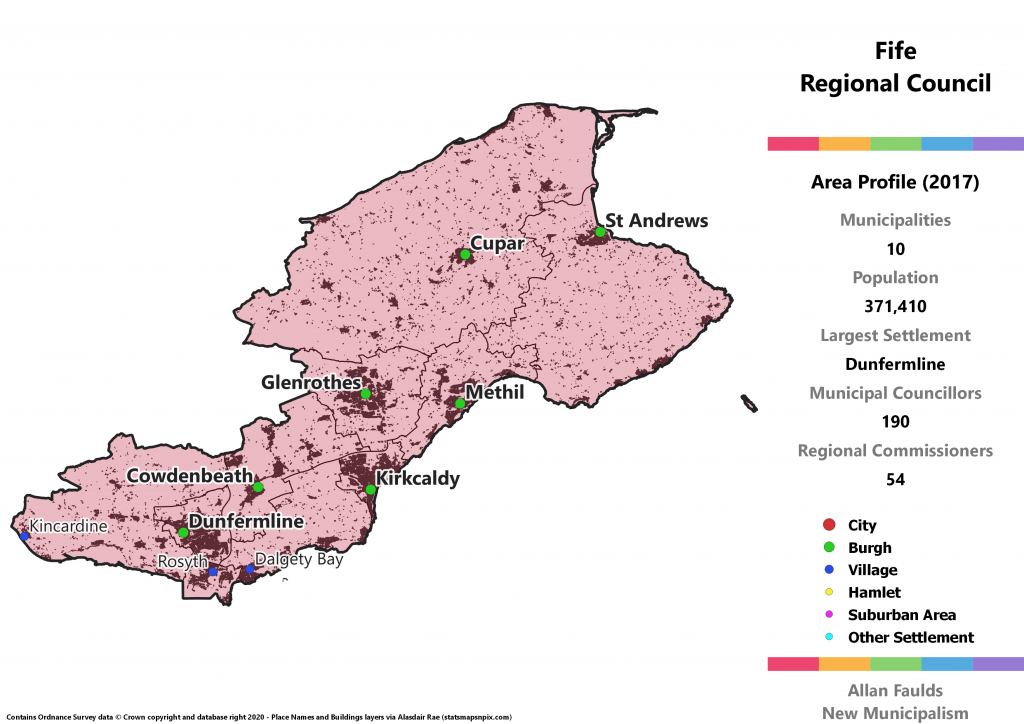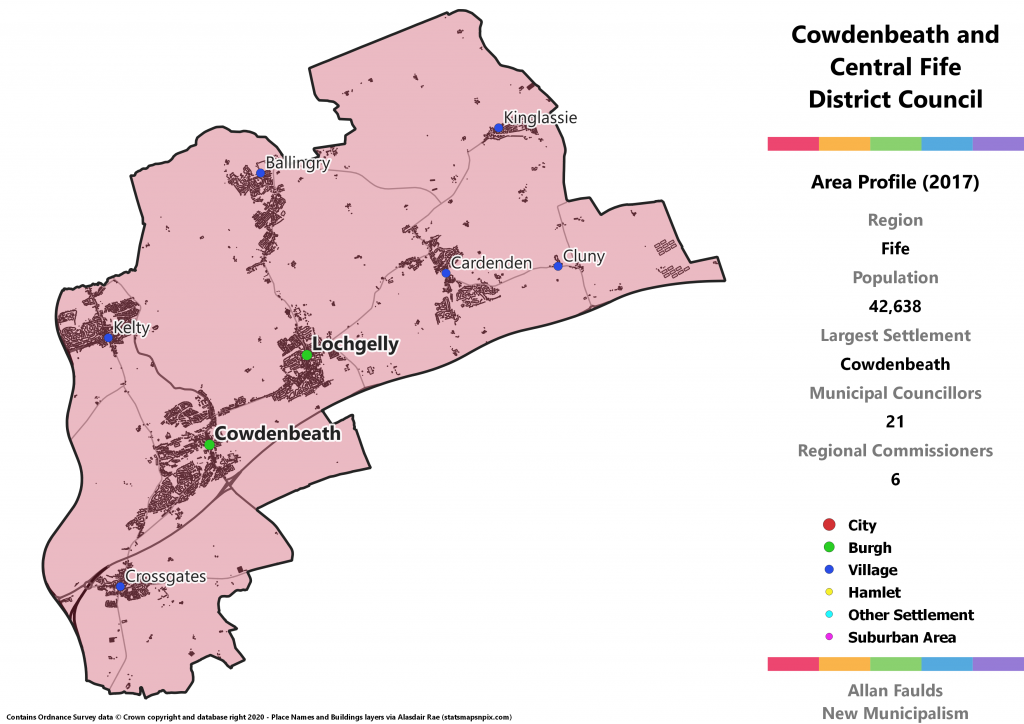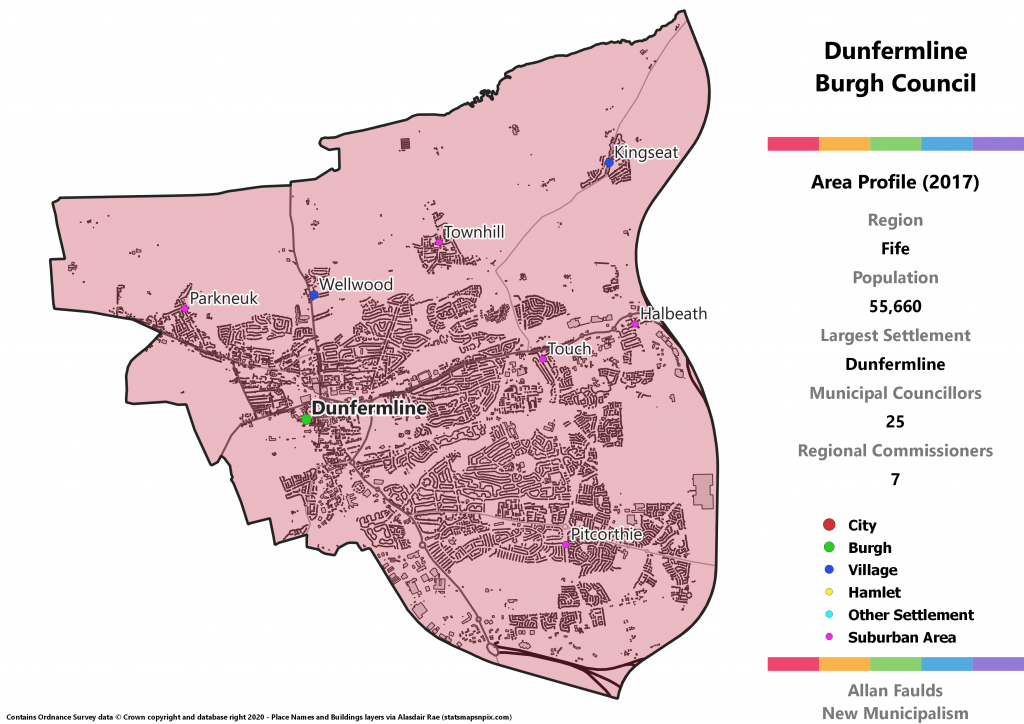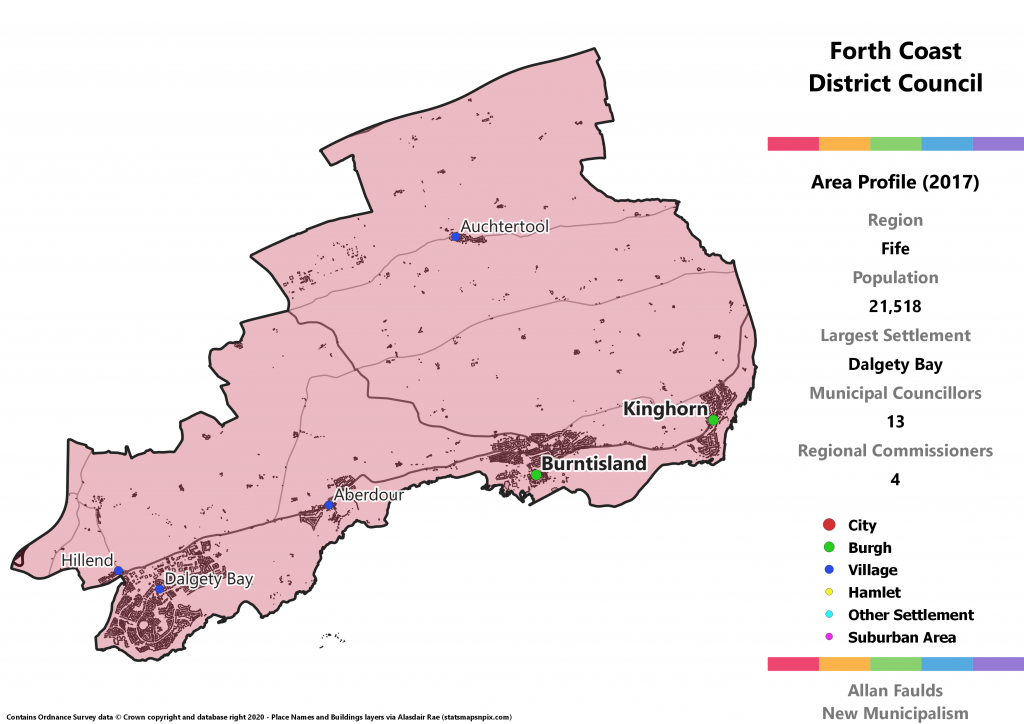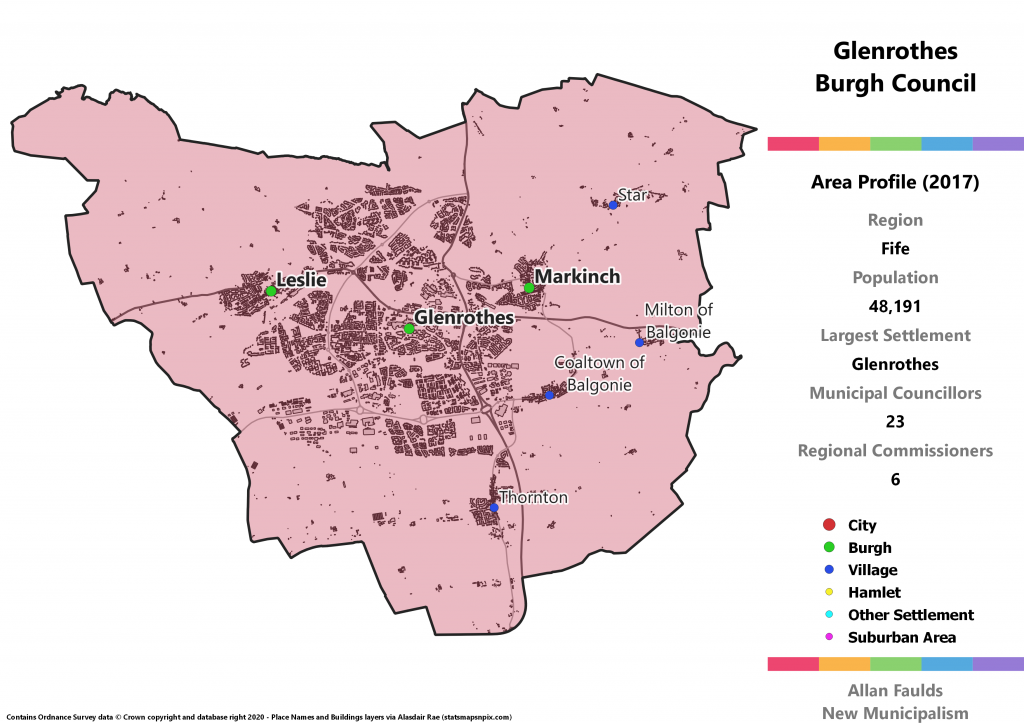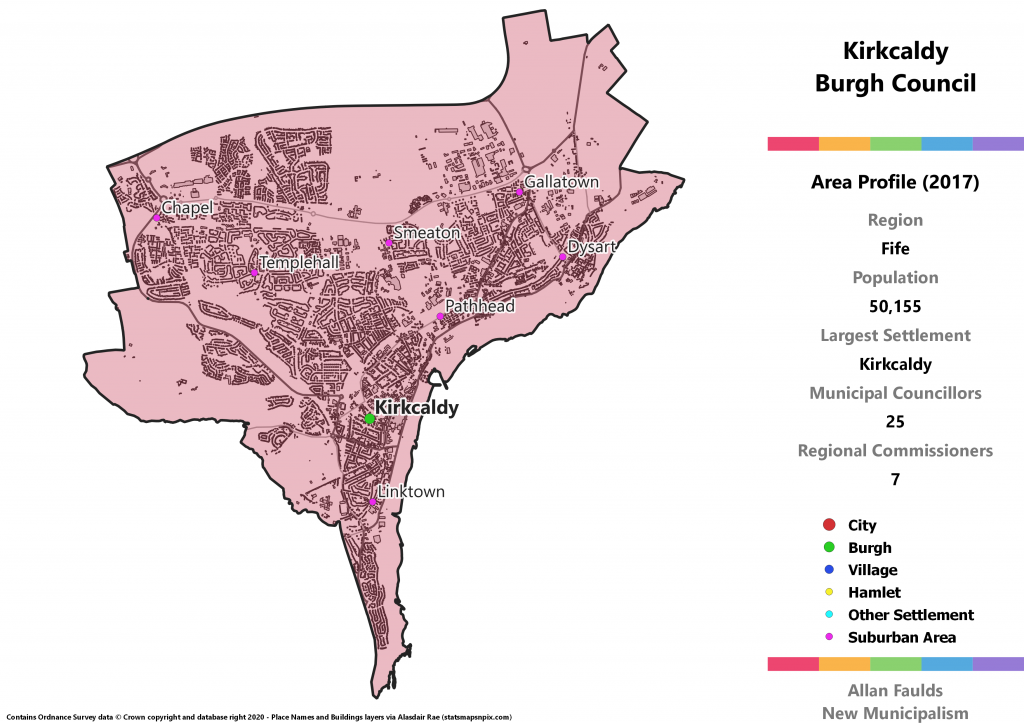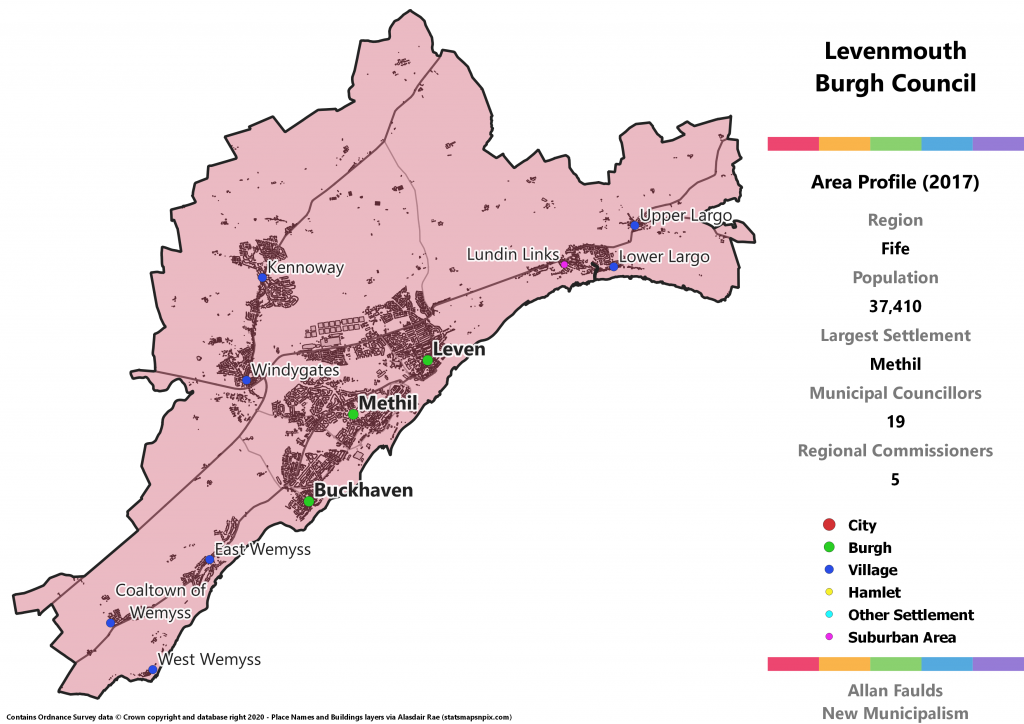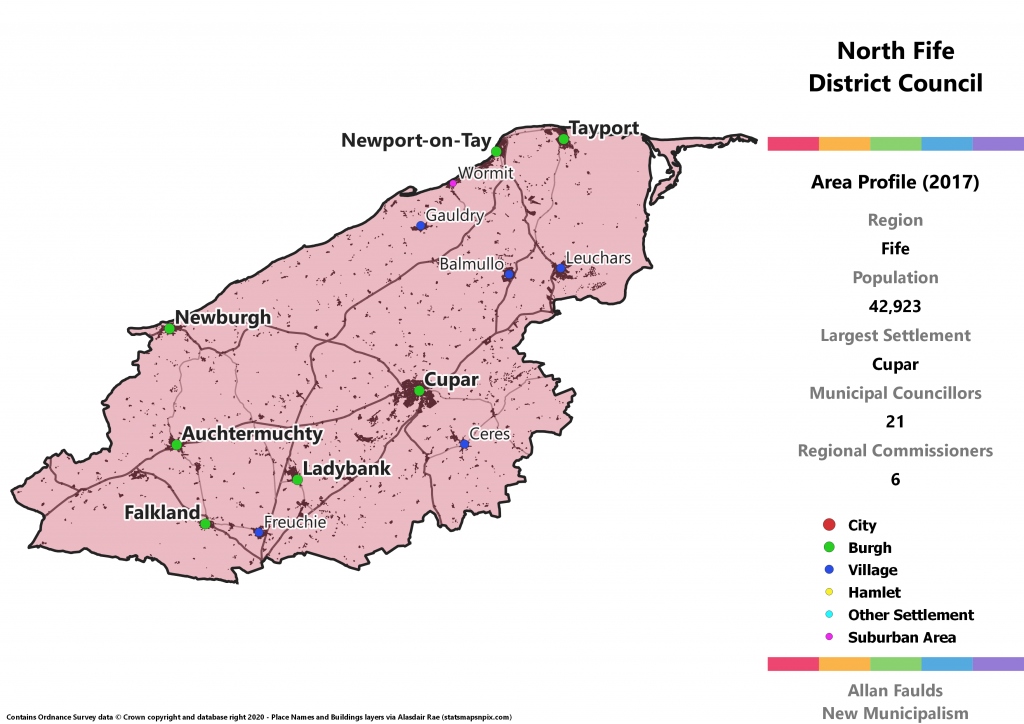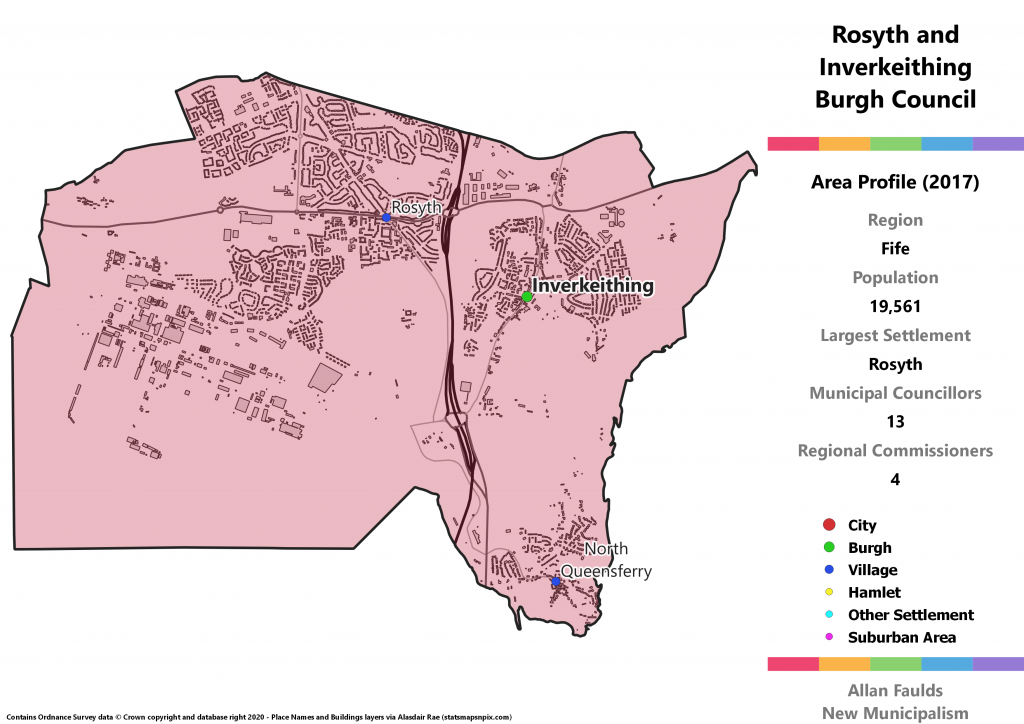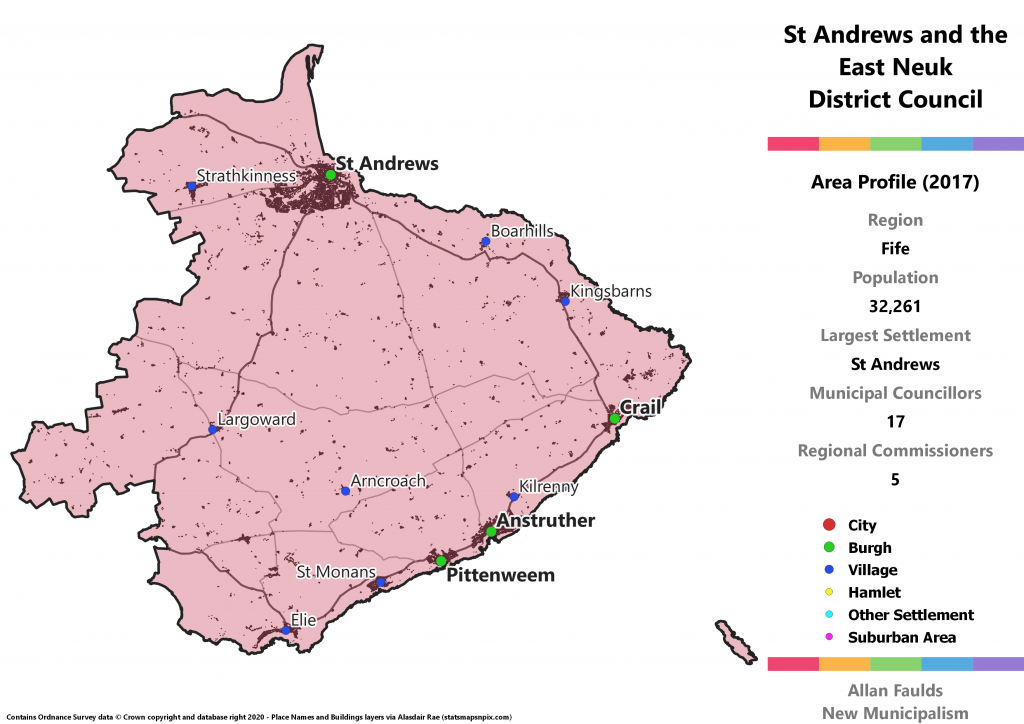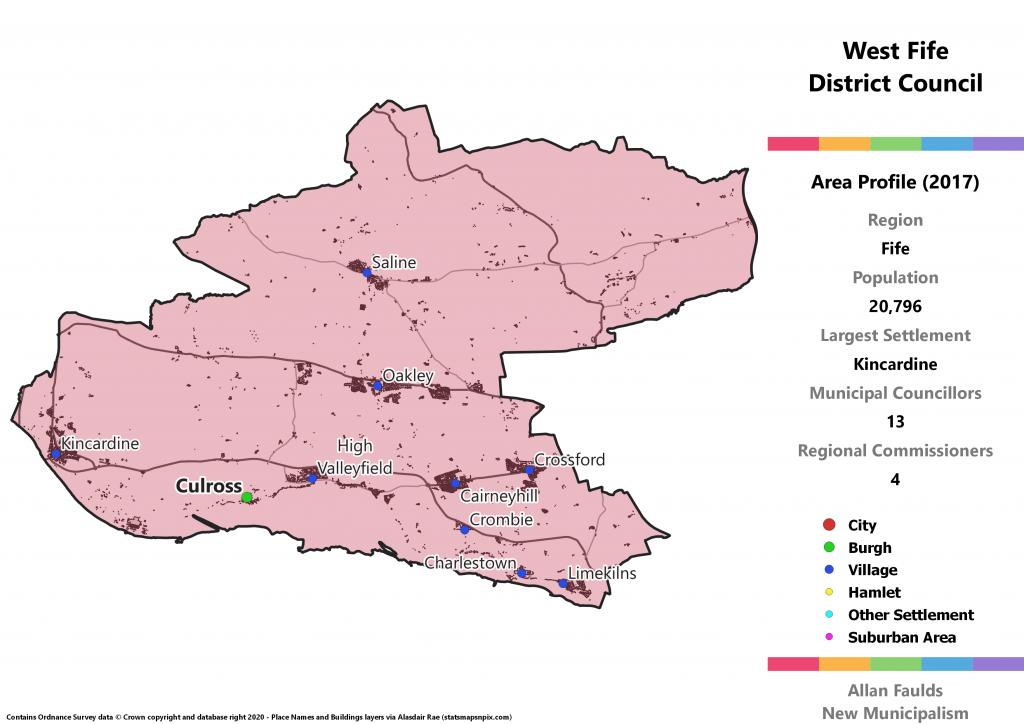Fife Region Overview
Key Statistics
Municipalities: 10
Population: 371,410
Largest Settlement: Dunfermline
Municipal Councillors: 190
Regional Commissioners: 54
Region Description
Fife is Fife, as it has always been, and always will be. It’s a brave person who would mess with the overall boundaries of the Kingdom these days. The Wheatley Report which preceded the 1973 Act proposed splitting Fife between multiple regions, and the Government initially intended on doing so when it brought the Bill to Parliament. It was faced with such a massive barrage of criticism from the public and from MPs it eventually relented and gave Fife its own region.
Not only do I not want to incur the wrath of Fifers, who have without a doubt the strongest regional identity anywhere in mainland Scotland, I do genuinely think it makes for a sensible region. The present Fife Council is to urban Scotland what Highland Council is to rural – an absurdly, unjustifiably huge amalgamation of distinct areas that absolutely could and should have their own local municipalities as they would in any other European country, but which also nonetheless make for an obvious wider area to co-ordinate services across.
Although this is therefore a third outing for some kind of Fife-wide administration, after the old County and then the 1973 Act Region, it differs substantially from its predecessors. The old County contained a whopping 25 Burghs, most of them by now very small towns and villages, so that’s not something to emulate. The 1973 Region then went too far in the other direction, with a mere 3 Districts. In plumping for 10 districts in this version, I’m hoping I’ve hit the right sweet spot. Distinct Burgh councils for the big towns which should definitely have them, and wider but still compact municipalities for smaller urban areas plus the rural north east.
Fife has solid diversity in terms of the overall projected makeup of the Regional Council, with the SNP having overtaken Labour as the strongest party. Labour do still remain in second, though the Conservatives have recently experienced remarkable growth and wouldn’t be far behind. Home to a long-standing Lib Dem stronghold as well, this would be that party’s third strongest area in the country.
Cowdenbeath and Central Fife District
Area Profile (2017)
Population: 42,638
Largest Settlement: Cowdenbeath
Municipal Councillors: 21
Regional Commissioners: 6
Municipality Description
Cowdenbeath and Central Fife effectively bunches up all those towns and villages in the urbanised centre of Fife which aren’t either on the coast or big enough for their own municipality. That gives it quite a large population by District Council standards in this project, but as ever this seemed the most sound division.
This district is one of the few that Labour would have led in based on 2017 results. Given that most of the area is in what was historically Gordon Brown’s Kirkcaldy and Cowdenbeath constituency which was won back by the party at the snap election the next month, that perhaps isn’t surprising.
Dunfermline Burgh
Area Profile (2017)
Population: 55,660
Largest Settlement: Dunfermline
Municipal Councillors: 25
Regional Commissioners: 7
Municipality Description
Dunfermline a huge town, and the fact it currently lacks its own council is a strong argument against the current local government setup. In my proposals it absolutely justifies a Burgh Council, re-instating the one abolished by the 1973 Act. In what is a bit of a rarity, although there are some areas where I’m proposing expanded boundaries versus the old burgh due to growth, I’m actually chopping a whole area off. Rosyth was in the old burgh and hasn’t been included here.
Dunfermline remains a bit of a stronghold for the Lib Dems despite their weakened status in recent years. Extrapolating from 2017 results, it’d have been the only part of Fife outside the very Lib Dem friendly north east where the party would have won more than a single councillor or won a vote share in double figures.
Forth Coast District
Area Profile (2017)
Population: 21,518
Largest Settlement: Dalgety Bay
Municipal Councillors: 13
Regional Commissioners: 4
Municipality Description
Forth Coast covers, unsurprisingly, the coastal towns and villages in between the major towns of Dunfermline and Kirkcaldy – plus one wee inland village at Auchertool. Most of this area is pretty affluent, especially Dalgety Bay. That’s likely to explain why based on 2017 results this would have been the only Fife municipality where the Conservatives were the largest party.
Glenrothes Burgh
Area Profile (2017)
Population: 48,191
Largest Settlement: Glenrothes
Municipal Councillors: 23
Regional Commissioners: 6
Municipality Description
One of Fife’s three big towns, Glenrothes is also the youngest of them. It’s one of the post-war New Towns, and it never even got the point of getting its own Burgh before the 1973 Act abolished those. It’s now the kind of size that it really isn’t well served by simply being part of one of Scotland’s daft jumbo Councils.
Lying in between and having largely absorbed the former Burghs of Leslie and Markinch, Glenrothes’ central location in Fife has led to it serving as the administrative capital of the Kingdom for the past few decades. This proposal also incorporates a few outlying villages that are either contiguous with or clearly in the orbit of the town itself.
In political terms, Glenrothes is strongly supportive of the SNP. Extrapolating from 2017 results, this would have been one of those rare one party majority councils.
Kirkcaldy Burgh
Area Profile (2017)
Population: 50,155
Largest Settlement: Kirkcaldy
Municipal Councillors: 25
Regional Commissioners: 7
Municipality Description
The last of Fife’s trio of big toons, Kirkcaldy is yet another one of those historic Burghs which was stripped of that status by the 1973 Act. Under any sensible system of local government that should never have happened, so that status is restored in this proposal. Unlike many of the other historic Burghs, the boundaries here don’t differ very much from the old version, as the town hasn’t grown very much beyond them and doesn’t need to draw in chunks of countryside with no other place to go.
In addition to being one of those relatively few areas where Labour are the expected largest party on the basis of 2017 results (remember, Labour won the Westminster seat the next month), there are enough councillors for the Greens to take a seat here too. That’d be the only Green in the urbanised South of Fife.
Levenmouth Burgh
Area Profile (2017)
Population: 37,410
Largest Settlement: Methil
Municipal Councillors: 19
Regional Commissioners: 5
Municipality Description
The heart of this one is the Levenmouth conurbation, centred on three towns that formed two Burghs before the 1973 Act – Buckhaven & Methil, and Leven. It also draws in surrounding villages including the Wemyss, Largos, Windygates and Kennoway. Given the size and coherence of that urban core, I’ve reckoned this worthy of Burgh status rather than District, although that’s just a matter of nomenclature rather than powers. This is an otherwise unremarkable municipality that I don’t need to much explain.
North Fife District
Area Profile (2017)
Population: 42,923
Largest Settlement: Cupar
Municipal Councillors: 21
Regional Commissioners: 6
Municipality Description
The northern portion of Fife is quite different to the southern end, being less urbanised and looking more to Dundee than Edinburgh as its neighbouring city. North Fife covers the area along and inland from the Tay coast, most notably including the Kingdom’s historic county town of Cupar. There’s quite a large population here that you could possibly split further into “Tay Coast” and “Howe of Fife” Districts if you were so inclined, though I decided against doing so here.
The north east of Fife in general remains a Lib Dem stronghold despite their recent slump, and it shows in local election results here. Extrapolating 2017 results out to this district shows the party with a commanding lead over its nearest rivals, though still short of a majority. This would be the only Fife municipality with no Labour representation, but it would have a Green.
Rosyth and Inverkeithing Burgh
Area Profile (2017)
Population: 19,561
Largest Settlement: Rosyth
Municipal Councillors: 13
Regional Commissioners: 4
Municipality Description
Having chiselled Rosyth out of its traditional affiliation with Dunfermline to pair it with Inverkeithing, this Burgh falls very slightly short of the 20,000 goal even with the inclusion of North Queensferry. I reckoned close enough was good enough here, in the interest of providing a reasonable level of local governance.
This is one of those municipalities that delivers a majority council, in this case for the SNP. There’s a certain amount of benefiting from the small size of the council there however, as an Independent and the Lib Dems pull a fair share of the vote but not enough to squeeze in with just 13 seats up for grabs.
St Andrews and the East Neuk District
Area Profile (2017)
Population: 32,261
Largest Settlement: St Andrews
Municipal Councillors: 17
Regional Commissioners: 5
Municipality Description
St Andrews is the largest town in Fife outside of the urbanised south, but it’s still not quite big enough to revive its old Burgh per this project’s rules. It’s therefore instead combined with the picturesque East Neuk and the string of small former fishing villages (and in some cases, Burghs) along the widest point of the Firth of Forth.
As this is the north east of Fife, the Lib Dems are the strongest party here. Perhaps because of St Andrews’ status as a University Town, extrapolating 2017 results for this district suggest it’d be the most diverse in Fife, with all 5 Holyrood parties represented on the council.
West Fife District
Area Profile (2017)
Population: 20,796
Largest Settlement: Kincardine
Municipal Councillors: 13
Regional Commissioners: 4
Municipality Description
Although this district looks rather rural by the standards of the southern end of Fife, West Fife is actually quite highly urbanised – it’s just into a dizzying number of small towns and villages along the coast and interior. Many of these are former mining villages, from when the Fife Coalfield was a major centre of the industry. Those days are long gone now, but it does mean the area has a distinct character that is certainly worth representing with its own council.
The area around Kincardine in the furthest west, which borders Clackmannanshire and is home to two bridges to Falkirk, has had repeated proposals to be broken off. Both the initial draft of the 1973 Bill and the proposals for 1994 suggested it be joined to those other areas. Even that relatively small change has never made it through Parliament, assuring the inviolability of Fife until the present day.
